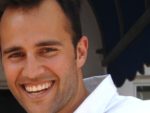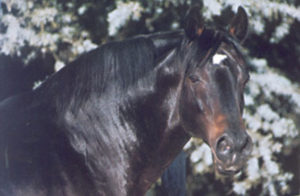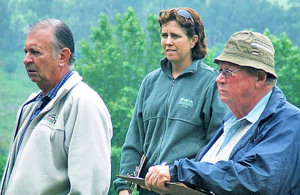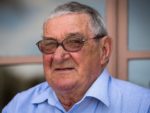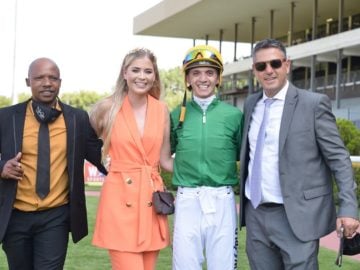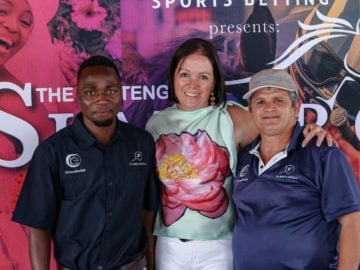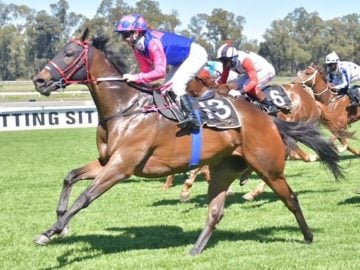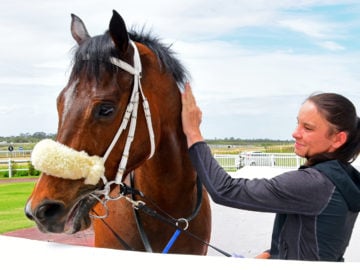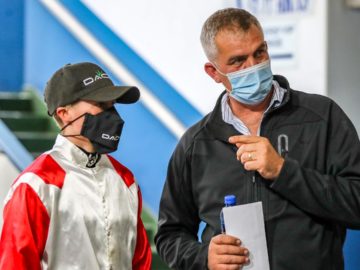At the 2015 Cape Racing and Breeding Awards, the Cape Breeders Club presented an Industry Service Award to John Kramer who, in the words of Chairman Vaughan Koster is “principled, kind and loving and where the horse always comes first. He is loved and respected by his peers and experts alike for his incredible experience.”
John has the quiet, unhurried way of someone with a lifetime’s experience around horses. When we congratulate him on his award, he smiles shyly and shrugs modestly at the fuss. “It’s a great honour, I must say. Most unexpected. I always like being under the radar, not on the radar, but it was wonderful to be honoured by your peers, you know? It’s been wonderful to be associated with the horse, from when I ate manure as a baby to where I’m standing today. At the end of the day, that’s why we’re there. My life has been extraordinary thanks to horses. I’ve bred them, sold them, raced them, managed studs all over the world – it’s been a wonderful life. I must thank the Lord for giving me all these opportunities. And I’m still learning – that’s the wonderful thing about the horse – you always keep learning. And hopefully that’s how I can live out my life.”
Family
John has the most extraordinary family history, with roots stretching all the way to Russia. “It’s a long story,” he chuckles, but it’s quite fascinating how I came into this world.” Over several generations the family fled from Germany to Russia and back again. “My father was a linguist and could speak seven languages, so he got a job with an English railway company to build a railway in Serbia. He was the paymaster and living in Belgrade. My father loved riding, got into horses and owned the Yugoslav Derby winner. My mother Hilda was one of the Rhodesian Meikles and married to an Englishman who was actually an MI5 agent. His cover was as the Rolls Royce agent in Yugoslavia. My parents got together, but they still had very old fashioned ways in those days – my mother’s husband was Catholic and she couldn’t get a divorce until they could prove adultery. They left Europe just before the war and came to Cape Town. They bought a property and started a little stud and riding school in Kuilsriver – my dad used to give lessons and so on. I was born in Cape Town and finally they had the proof that they needed for the divorce and could finally get married.”
George Kramer became a highly respected and successful breeder, standing such stallions as Soldier King, Royal Chaplain, Giafar, Tiger Fish and the wonderful Ranjit and he produced horses such as Marion Island and Hyacinth. He established the Askania Nova Stud in the Middleburg district in the early 1940’s, later moving to Broadlands in Sir Lowry’s Pass in 1952.
Grass roots
“My association with horses started at the time I sat outside Soldier King’s stable and ate manure,” he says matter-of-factly. “My father had to do something with the stallion, so he sat me outside the stable. They’d just mucked out and there were heaps of manure. I didn’t have anything better to do, so I tried it out and that’s how I started! My dad would pay me half a crown to go down before school and see what mares had foaled. If the horses were foaling early, he used to take me with him to help foal them down. That’s where I got my basic training.” After school, John spent two years working on a cattle and horse farm in Namibia, returning to work for his father until he died in 1965.
Broadlands was sold to Lady Kenmare, with John staying on to manage the farm for a while, before a stroke of luck landed him a job with Countess Batthyany. “It’s amazing how it all worked out. I had a friend who worked at the Austrian Embassy in Cape Town. Whenever she had a weekend off, she asked to come to the farm and I’d take her around and show her the horses. One day she phoned and said the Countess was looking for a manager on her German farm (Gestut Erlenhof) – her old stud master was getting old and she was looking for a younger man and would I be interested. Of course I said yes. I met her in Salisbury for an interview and she said ‘Wonderful. What I’m going to do with you is send you to Ireland to my farm there for a year and after that for another year to EP Taylor’s farm in Canada. Unfortunately I only got as far as Hamburg. I was visiting my 90 year old grandmother – who I met for the first time in my life – and on Christmas eve I had a call from the Countess to say ‘Bad luck, the old man has just died’ so I started on 1 January 1966.”
Revolutionary ideas
“You only got into the top job there when top dog died and by then YOU had grey hairs. The first foals were born at the end of January, but the system was that the horses were stabled until April. I wanted to take the mares out with the foals. There was a nice layer of snow in the paddocks and the old head groom, who’d probably been there 50 years, said you’re mad, the foals are going to die. I said they won’t die and they were so happy to get out, run around and roll in the snow. It was a helluva shock to the German industry to have a 28 year old manager on one of their major studs – it caused quite a bit of excitement.” In the interim, Gisela was completing her midwifery studies in Cape Town. She came over to join him, the couple got married and both their sons were born in Germany.
Gestut Erlenhof stood the great Orsini and during his tenure they produced horses such as German 1000 Guineas winner Dulcia, German Derby victor Marduk and French 2000 Guineas winner Caro. The Countess also purchased Ballykeen Stud in Southern Ireland and Haras Bois Roussel in France, which John helped develop, before returning to South Africa in 1972.
South Africa
John advised Artur Pfaff to purchase Daytona Farm in 1975 and helped develop it into a stallion station and boarding stud. One of John’s greatest achievements was designing the mating for 1979 Prix de’l Arc de Triomphe winner, Three Troikas. “We also bred Elliodor. His dam was a great big rough mare and Lyphard was this short, high quality Northern Dancer – we put the two together and Elliodor came out.”
Elliodor was not an immediate hit in South Africa. “Terrance Millard came to look at him and said ‘No John, you don’t know what you’re doing. He’s got a steep shoulder and no quarter.’ Elliodor was his own man. He stood over a lot of ground and didn’t look like a Northern Dancer, but when I saw his first foals, I knew. We battled to sell shares to Colin Cohen – it took him a year to pay for them, but he bred Model Man (South Africa’s first equine millionaire). Elliodor had 13 foals in his first crop and 6 were top division winners with Model Man amongst them. After that everyone came running.”
Seldon Stud
It was while working at Daytona that John met Georgina Rogers. “I’d bred Sweet Chestnut for Hymie Maisel at Daytona – he had his mares at Daytona before he bought Hyjo. Georgina had come into the game and bought Sweet Chestnut at the 1977 Goodwood Sales. That’s where she started. She used to board horses at Daytona and eventually we fell in love. I got divorced and married Georgina in 1983 and we started Seldon Stud in Ceres.” They built the 3,000ha property from scratch, standing the stallions Beldale Lustre and Saturado and perhaps just as interestingly, JBK Cooper’s The Maltster as their teaser. Unfortunately, the 1987 flu epidemic proved disastrous. “We lost nearly the entire yearling crop, got into financial problems and dispersed in 1988, selling to our neighbour Wilfred Koster and Rob Hamilton.”
Divorcing Georgina in around 1994, John lived alone for about 10 years before reconciling with Gisela and they remarried in 2004.
Inspector Extraordinaire
John joined the Thoroughbred Breeders’ Association (TBA) as a liaison officer in 1988 and also started inspecting yearlings. He relates, “We had around 800 breeders at the time. Of course some where chequebook breeders, but there were still around 300 farms to visit. I travelled all over the country.” It’s estimated that he must have covered close on 400 000km and inspected almost 25,000 yearlings to date. A story from one of these trips has become something of a legend. “Tobie Spies and I had inspected at Maine Chance in the afternoon and were due to spend the night with Marianne Thomson in Worcester. By the time we left it was starting to get dark, so I said to Tobie, ‘I’m not going to drive all the way round – we’ll take the short cut through the back hills and across Breede’. We knew the river was down, so when we got there we looked to see how far it was over the low water bridge – it didn’t look too bad from the side and I said to Tobie ‘Ag man, it shouldn’t be a problem.’ When we got to the middle of the bridge, the water lifted the car up, pushing the front wheels over the edge. We got out and Tobie hung unto the car by the front and back door handles, while I grabbed two suitcases from the boot. Eventually Tobie couldn’t hold it anymore and the car floated off down the river and sank. Fortunately the cell phone worked and Marianne picked us up. The car was a write off, but we got the briefcase with the money and our files – fortunately they were still legible. We dried them all out in Marianne’s oven, hired a car and carried on. They’ll be pulling my leg with that for the rest of my life!”
Wonderful life
Is there a secret to picking yearlings? “Horses always make fools of you. Obviously you’ve got to see a horse grow up to judge them at their various stages of development – it’s just a matter of experience and having the eye. I supposed some people never learn, but fortunately I was able to learn.”
One of his greatest success stories locally was purchasing the Daarik filly Night Diva at the 2yo sales. She was crowned Equus Champion Staying Filly in 2003 after winning four feature races. Other memorable horses include 1982 Rothmans July winner Jamaican Rhumba and the Jean Heming-trained Poetic.
In 2014, John moved from the TBA to Cape Thoroughbred Sales to do yearling inspections. He still does bloodstock consultancy work, with his main client being Ben Sahd (Waterford Stud), but he admits that the landscape has changed. “These days it’s just becoming too expensive for the ordinary man on the street to buy horses. You’ve got to go for quality, it’s the only way to survive. It’s a great pity really, the smaller owner/breeder contributed a lot to the game and they breed a good horse. We saw that again at the awards with the likes of Variety Club and Captain Of All. They’re the backbone of the industry at the end of the day. In my day we also had 6 or 7 big owners and they all lived and let live. Now we’ve only got one or two – it’s not healthy. But, I believe the industry is in good hands and one just has to remain optimistic.”
“At the end of the day, it’s been a wonderful, interesting life and I am so lucky to have gone on this long journey thanks to horses.”
‹ Previous
